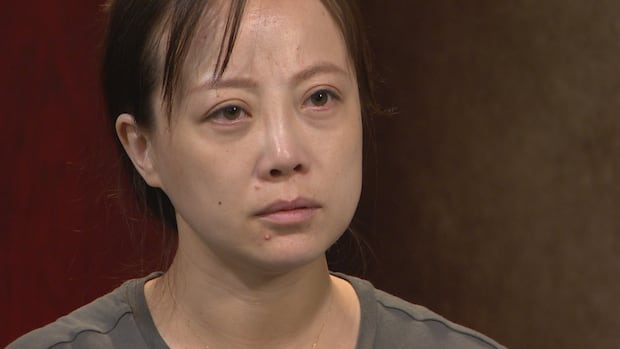TingTing Biao remembers the moment she realized she lost everything, including tens of thousands of dollars in savings, on an immigration scheme that left her broke and traumatized. A donated loaf of bread was all she could offer her child.“My daughter eats one meal in the whole day,” Biao said, her voice trembling during an interview in Saskatoon this August.Instead of a new life in Canada, Biao is now back in China warning others about what happened — a dream that turned into a nightmare.In January, Biao and her husband arrived in Canada on tourist visas with their six-year-old daughter, intending to explore their options for moving here permanently.TingTing Biao’s six-year-old daughter Jojo at an airport in Canada. The family arrived on tourist visas but wanted to find a way to stay permanently. (TingTing Biao)She signed a contract with Jun Su and June HR Solutions in Saskatoon. Biao said she was referred to the immigration company by a friend and believed that an agent who is also of Chinese descent would be trustworthy. Su, who presented herself as an immigration consultant, offered what looked like a clear path to permanent residency — for a steep price tag of up to $110,000. Biao ended up paying $40,000 before walking away.An expert told CBC that immigrating to Canada shouldn’t cost nearly that much; it typically costs between $5,000 to $10,000 to hire an immigration consultant for a process similar to Biao’s.Su is not a licensed immigration consultant.The College of Immigration and Citizenship Consultants (CICC) regulates the industry by licensing agents, setting guidelines and investigating complaints. It said anyone who illegally provides Canadian immigration advice for a fee or other consideration without being licensed is an unauthorized practitioner.Su said in a statement that her husband is a licensed agent and she gives immigration advice based on his guidance and her years of experience.A contract for failureCBC reviewed Biao’s contract with June HR Solutions. It laid out payments totalling $110,000 tied to several immigration steps, ultimately leading to permanent residency.CICC said in a statement that consultants must set “fair and reasonable fees,” but it doesn’t specify how much is reasonable, nor can it track how much agents are charging.CBC reviewed Biao’s contract with June HR Solutions. It laid out payments totalling $110,000 tied to several immigration steps, ultimately leading to permanent residency. (CBC Graphics)Biao paid the first $20,000 when she signed the contract and the next $20,000 after a successful labour market impact assessment (LMIA) — a document Canadian employers sometimes need to hire foreign workers.Biao received a positive assessment for a kitchen helper position, but an expert told CBC that job doesn’t qualify for Saskatchewan’s permanent residency pathway.Richard Kurland, an immigration lawyer with 40 years of experience said, “the plan was a plan for failure.”“Even if you get an LMIA as a kitchen helper, it gets you nothing,” Kurland said. An expensive detour and misleading adviceBiao’s next step was getting a work permit, which would be followed by another payment of $20,000 to Su, but Biao’s work permit application was rejected.Immigration, Refugees and Citizenship Canada said in a rejection letter that it was not convinced Biao would leave Canada at the end of her temporary work permit, citing family ties in Canada, inconsistent details in her application and an unclear purpose of visit.Su then suggested an even more expensive detour — invest $80,000 in a business in Yellowknife to apply for an investment visa. But that program requires more than $200,000, English fluency, business experience and a high net worth. Biao had none of those.This is when Biao realized she was out of options and decided to walk away from the contract. With all her savings gone and no prospects of a life in Canada, she was forced to return to China. Ghost consultantMost of Biao’s communication was with Su, who is not a regulated immigration consultant. CBC reviewed WeChat conversations showing Su giving instructions and immigration guidance to Biao over several months.Jun Su gave Biao immigration advice over several months. Including the messages in this conversation suggesting that Biao stay in Canada to wait for a work visa application that was eventually rejected. (TingTing Biao)June HR Solutions Inc. does have one licensed consultant listed — Su’s husband, Zheng Tao Liu. Su referred to Liu as “lawyer Liu” in WeChat conversations — but the Law Society of Saskatchewan confirmed that Liu is not authorized to practice law in the province.Immigration company’s responseSu declined CBC’s request for an on-camera interview, but emailed her response to Biao’s allegations. She said she serves as an assistant to her husband, who is a licensed consultant, and that she gives advice based on his guidance and her years of experience.“In this role, I assist in serving clients, which I believe is both my right and my responsibility.”She also said that Liu, her husband, is a lawyer in China and that she never claimed her husband was a lawyer in Canada.When it comes to fees, she said Canada’s free market allows her to set her own fees.“Ms. Biao agreed to the pricing at the time of signing, so I do not believe the pricing should be a point of contention now,” she said.Su alleged Biao and her husband have damaged her professional and personal reputation.’Wild West’Kurland reviewed Biao’s documents and said her experience reveals a bigger problem of a major lack of oversight in the regulation of immigration agents.“It’s an open Wild West when it comes to consultants. People can charge whatever they want,” Kurland said. “You have to protect these people. They are vulnerable. They clearly do not know how our system works and what things really cost.”Kurland said Biao’s case is an example that shows CICC lacks the resources and authority to properly protect the public.“What concerns me the most is the amount of money in play for a simple permanent resident application, as well as the information and advice given to these people,” Kurland said.Solutions waiting on the shelfKurland said it’s clear that there are solutions to preventing issues like Biao’s.“It’s a known problem and it’s going to be up to the feds to fix it if they want to,” he said.His recommendations are:Parliament already passed legislation in 2019 to strengthen oversight of consultants, but it hasn’t been fully implemented. Kurland said enacting the changes would provide stronger regulation and an insurance fund to compensate victims.Publishing typical fee ranges for services like work permits and permanent residency applications, so newcomers know what’s reasonable.Giving the CICC more resources and authority, including the power to levy fines.Conducting random spot checks of consultants, rather than relying only on complaints.Lingering traumaNow back in China, Biao said the ordeal continues to haunt her family. After losing all her life savings, she’s trying to build again. She said she’s still sad and angry, and feels cheated by another person of Chinese origin.Biao said she’s sharing her story in the hopes of warning other foreign nationals and newcomers against similar schemes.She said that she is still haunted by nightmares from the experience.“In the dream, I’m crying,” she said.”My husband shakes me awake … and I’m still crying. It’s true.”
Price of a promise: Chinese family returns home broke after paying $40k seeking Canadian residency












